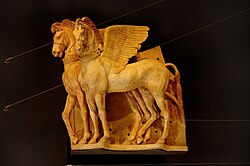User:Vallue/Winged-horses of Tarquinia
| Vallue/Winged-horses of Tarquinia |
|---|





The high-relief of the "Tarquinia Winged Horses" is a fragment of the colonnade that supported the pediment of the most important temple of the ancient Etruscan city of Tarquínia, at the Ara de la Regina, better known as the Major Temple of Tarquínia. Nowadays situated at the Province of Viterbo (region of Lazio, Italy)
Its realization dates back to the middle of the 4th century BC, although some researchers argued that it could be more recent, because only after the 3rd century BC Etruscan builders gave the temples a particular change in the decoration of the friezes and pediments.[1]
Features and Style[edit]
- Hellenistic influence
- The scene represented on the pediment of which winged horses were part was the staging of a god in a car, probably representing a solar deity.
- It was made by polychrome terracota, like almost all the reliefs of the pediments to the Etruscan constructions.
- Ara Regina temple was the largest and most important of all those built in Etruria.
Symbology[edit]
In spite of the stylistic influence of the classic Greek art, this set can not be identified with the only winged horse of Greek mythology, Pegasus, or with the horses that threw the car of Apollo. Therefore, it is a work of a purely decorative character, adapted to the Etruscan world. The image of winged horses has become the symbol and emblem of Tarquinia.
Etruscan civilization[edit]
Etruscans lived in Etruria, which included the Italian regions of Umbria, Tuscany, Lazio and Rome. The Etruscan civilization lasted from the 9th century BC. until the 1st AD, when adapted to the culture of the Roman empire.
Conservation[edit]
The relief is permanently exposed to the Tarquinia National Museum.It is part of an archaeological complex that began to work in the mid-twentieth century.[2][3]
References[edit]
- ^ Lulof, Patricia: Rescigno, Carlo, ed. (2009). "Deliciae Fictiles IV: Architectural Terracottas in Ancient Italy. Images of Gods, Monsters and Heroes" (PDF). Oxbow Books. ISBN 9781842174265.
{{cite journal}}: Cite journal requires|journal=(help)CS1 maint: multiple names: editors list (link) - ^ Jovino, Maria Bonghi (2010). "The Tarquinia Project: A Summary of 25 Years of Excavation". American Journal of Archaeology. 114 (1): 161–180.
- ^ "The Ancient Etruscan Civita of Tarquinia". Port Mobility Civitavecchia (in Italian). 2015-03-09. Retrieved 2018-08-08.
External links[edit]
- The National Archaeological Museum of Tarquinia.
- The Winged Horses - Tarquinia. (Myvisita.it)
- I Cavalli Alati del Museo Etrusco di Tarquinia - VT Video made on the occasion of the Notte Bianca di Roma 2006, when winged horses were exhibited for the first time at the Etruscan Museum of Villa Giulia in Rome (italiam)
